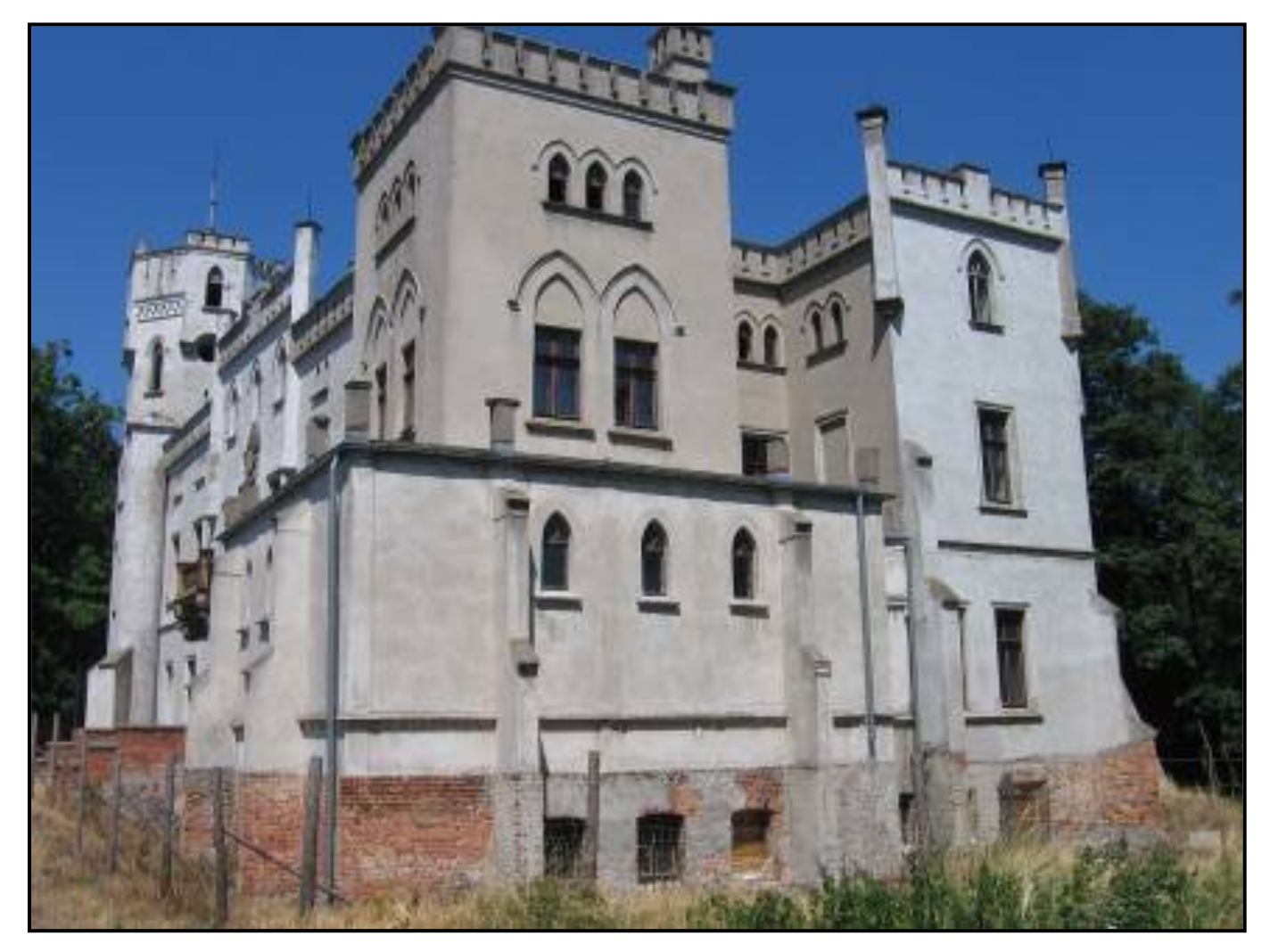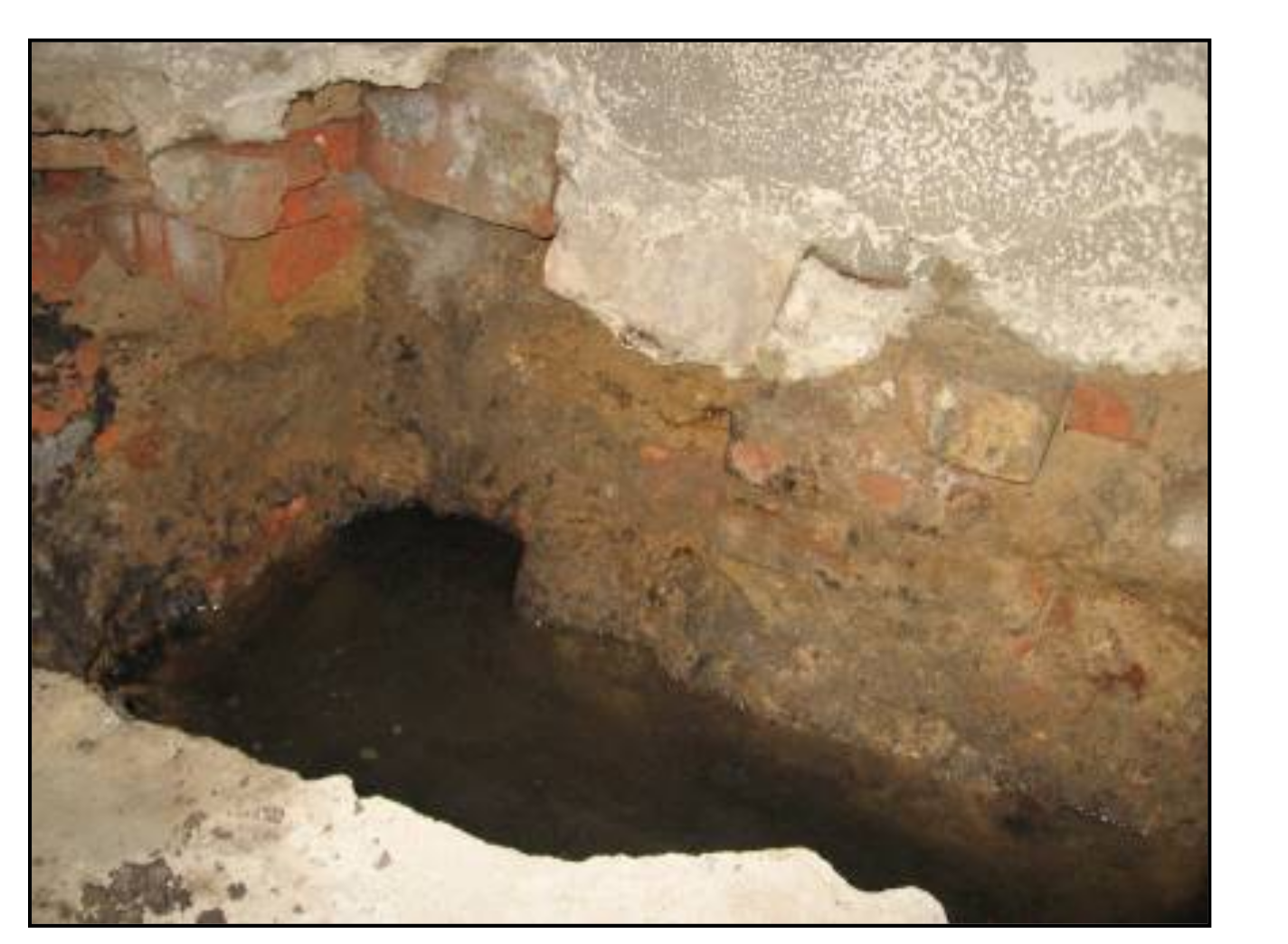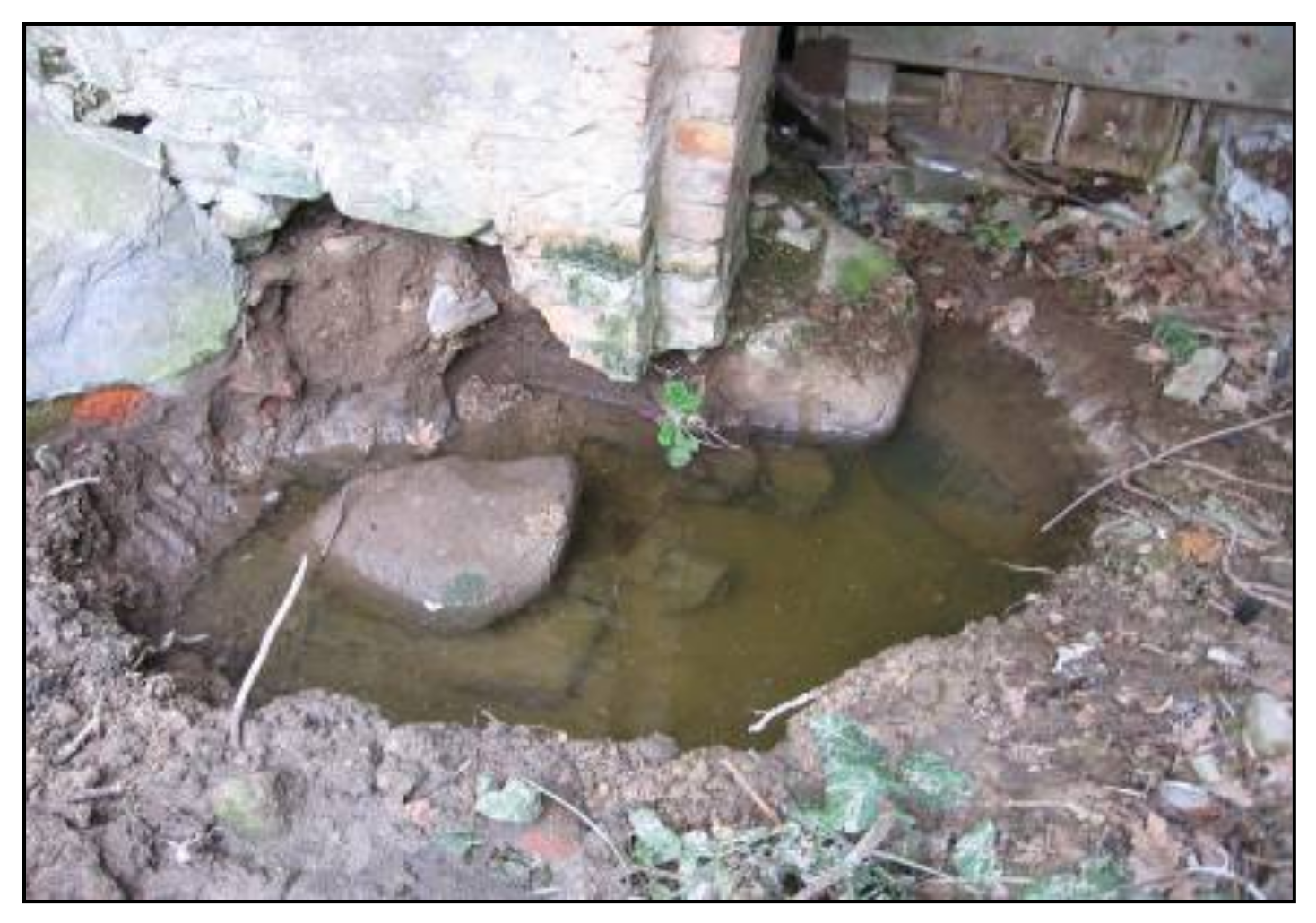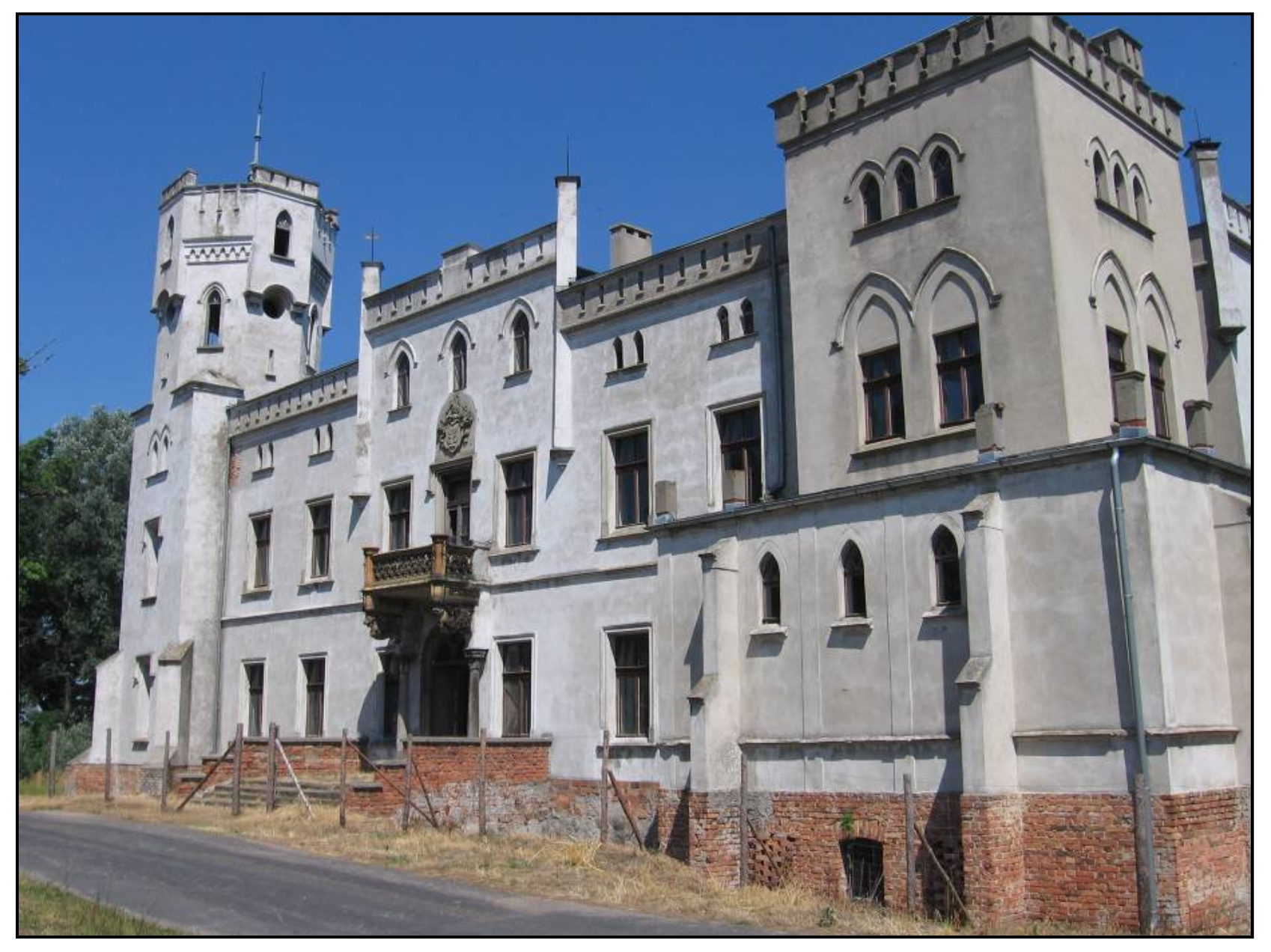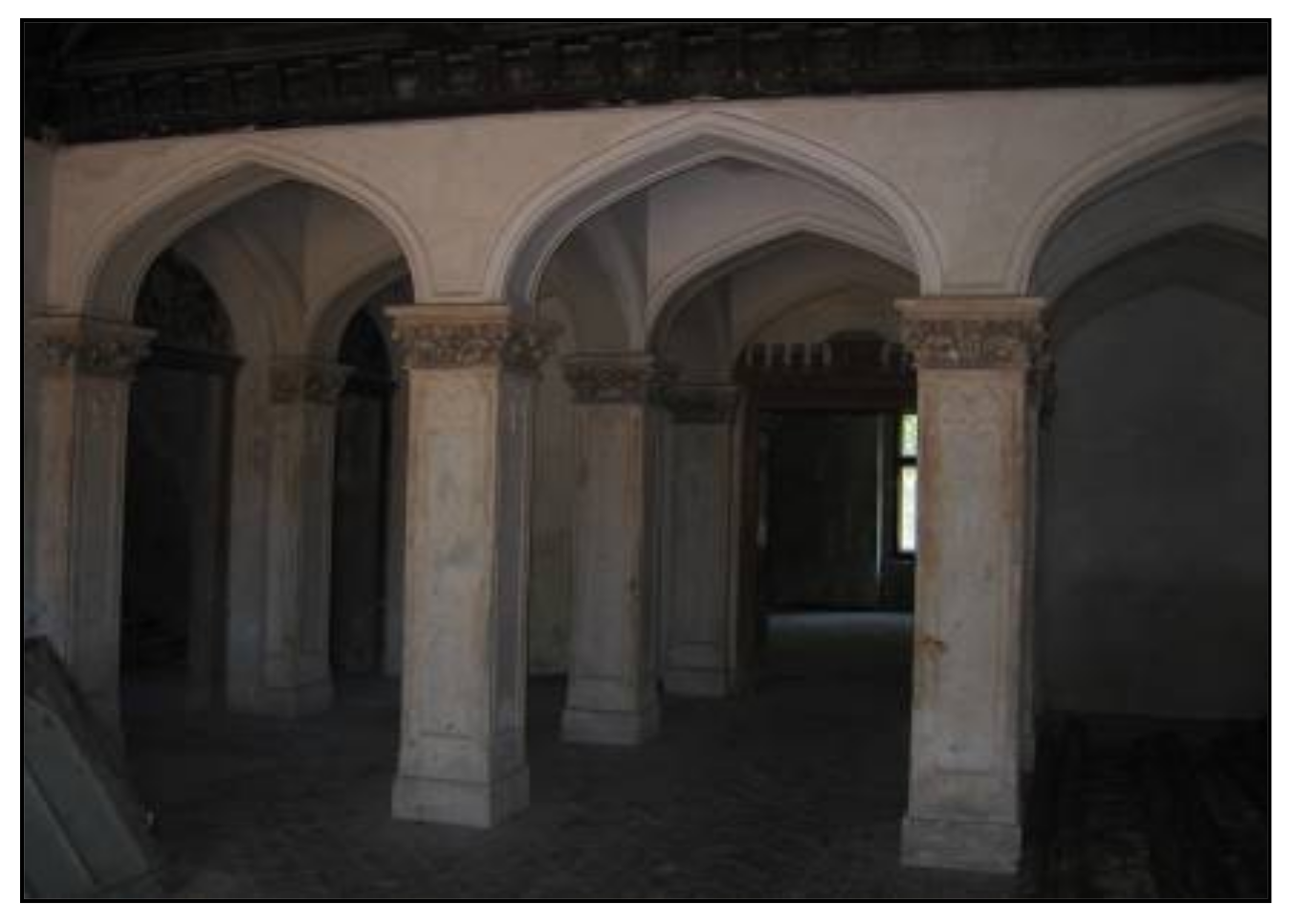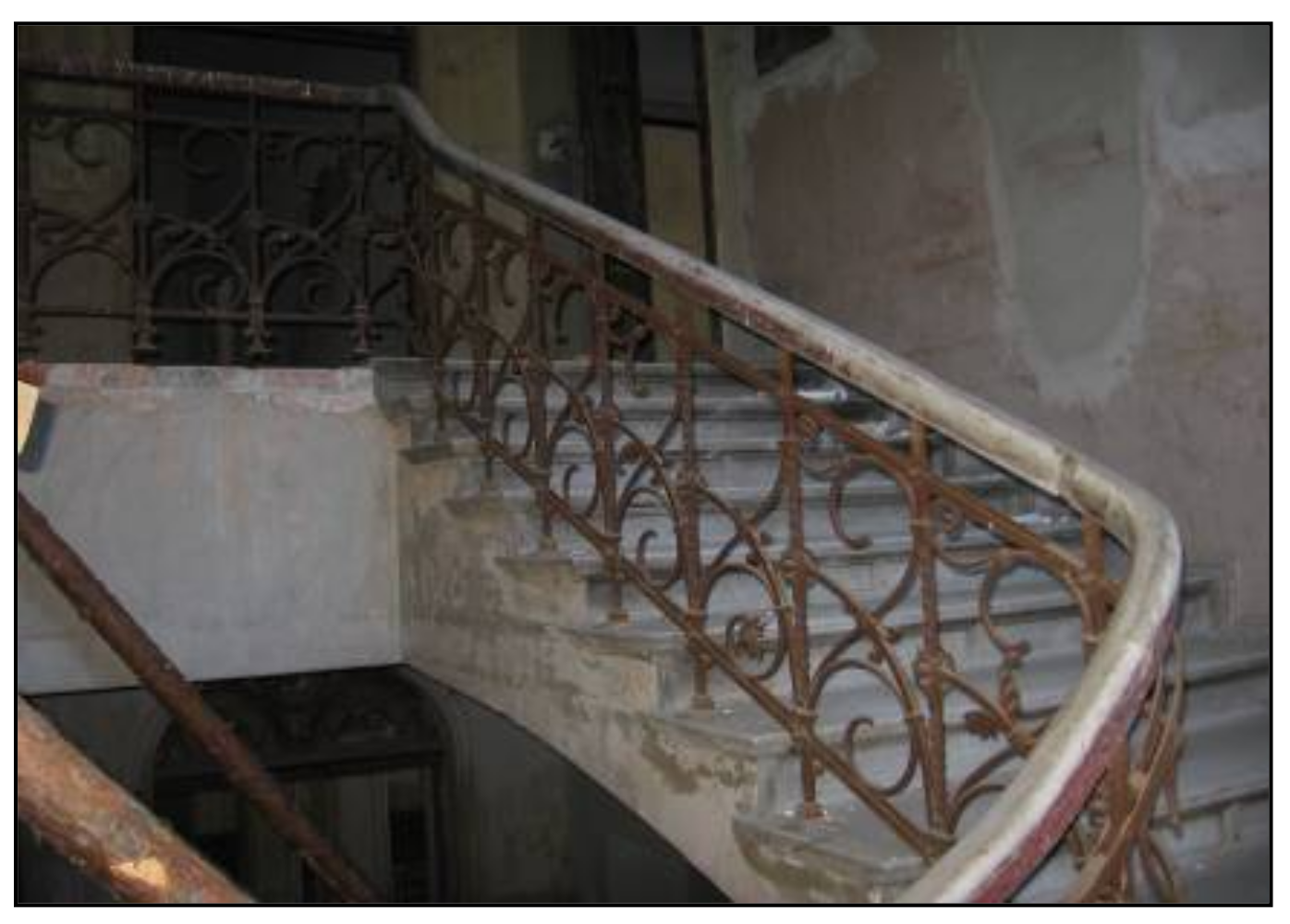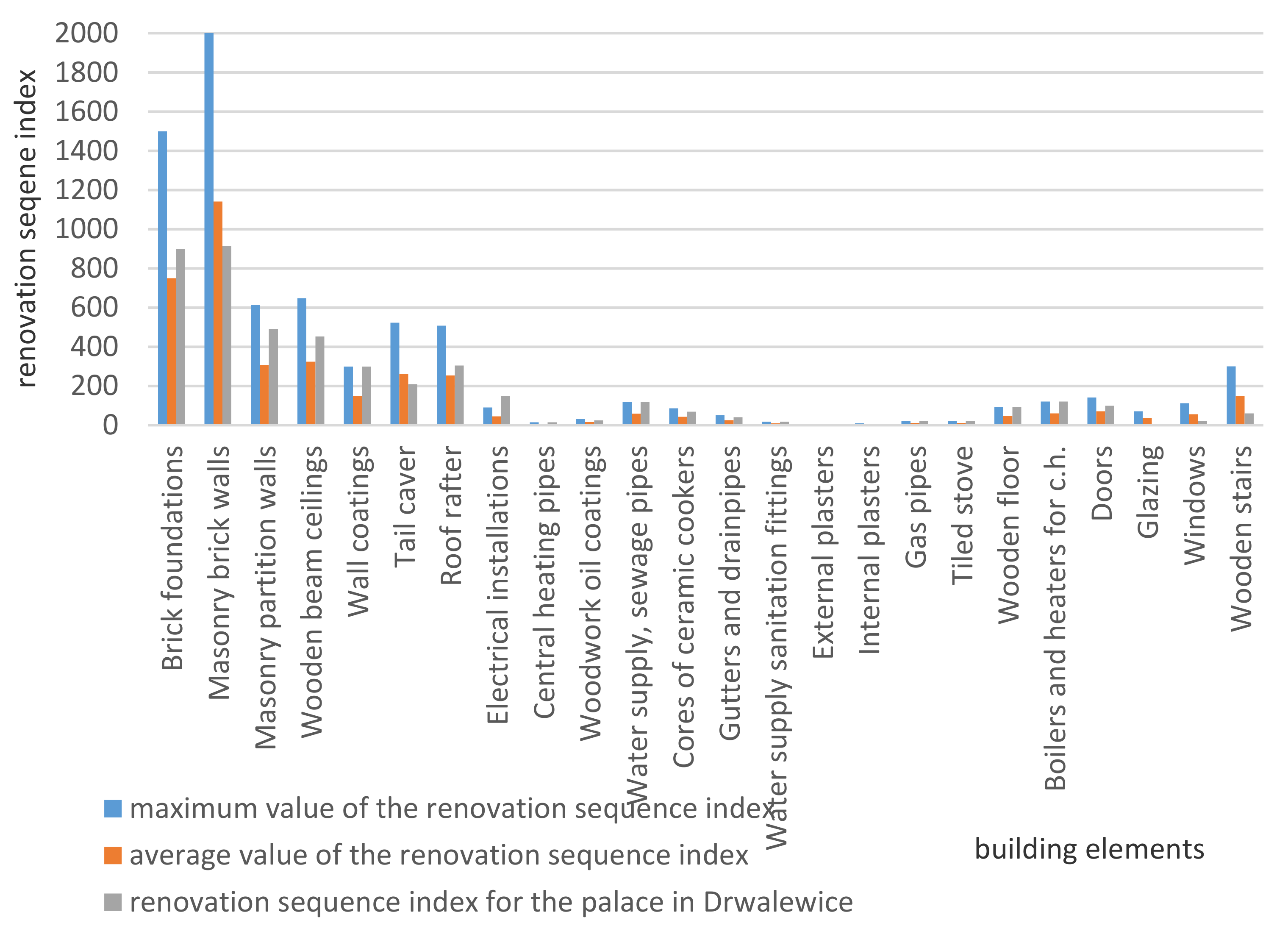Appendix A
A technical assessment of the palace was carried out.
The assessment of the technical condition of individual building components was prepared on the basis of carried out inspections (
Figure A1 and
Figure A2), periodic uncovering, and test measurements [
48].
Figure A1.
Fragment of the northern elevation. Numerous damp stains on the terrace, destroyed steps, and missing areas of plaster. Destroyed column caps.
Figure A1.
Fragment of the northern elevation. Numerous damp stains on the terrace, destroyed steps, and missing areas of plaster. Destroyed column caps.
Figure A2.
Southern elevation. View from the southwestern side. Walls covered by a cement-lime plaster applied in the 1980s. Note the lack of balustrade on the tower terrace and the lack of plaster on the foundation plinth.
Figure A2.
Southern elevation. View from the southwestern side. Walls covered by a cement-lime plaster applied in the 1980s. Note the lack of balustrade on the tower terrace and the lack of plaster on the foundation plinth.
The foundation of the building is composed of a strip foundation of various dimensions with an offset of 15 cm, made from boulders on lime mortar with an addition of clay; the average diameter of the boulders is approx. 60–70 cm. The depth of the strip foundation is approximately 80–120 cm below the level of the basement floors. Uncovering of the foundations in the northeastern and southwestern part of the building has been carried out. Severe damp from the groundwater on surfaces was determined (
Figure A3 and
Figure A4). The soil in areas of the foundation uncovered is loamy sand. The level of groundwater is above the level of the foundation and there is a lack of vertical and horizontal damp insulation.
Figure A3.
Basement in the middle part of the building (fragment). Foundation uncovered. High level of groundwater means a severely damp wall.
Figure A3.
Basement in the middle part of the building (fragment). Foundation uncovered. High level of groundwater means a severely damp wall.
Figure A4.
Wall of northern elevation (fragment). Foundation uncovered. Foundation from boulders and visible groundwater table.
Figure A4.
Wall of northern elevation (fragment). Foundation uncovered. Foundation from boulders and visible groundwater table.
The walls of the basement are made from boulders and class 7.5–10 fired, solid brick, with a cement–lime mortar (composition of mortar lime:cement:sand = 3:1:5), and plastered on both sides. The thickness of the walls ranges from 65 cm to 210 cm. The middle, and oldest part, is on laid in lime mortar with the addition of clay. The outside walls of the ground floor (thickness ranging from 70 to 82 cm), first floor (thickness from 42 to 82 cm), and attic (thickness from 20 cm to 54 cm) are made from fired, class 7.5–10, solid brick on lime–cement mortar (composition of mortar lime:cement:sand = 3:1:5), and are plastered on both sides.
Slight cracks and scratches, 1–2 mm in width, are present (e.g., a crack on the western wall running between the window openings at the level of the ceiling above the ground floor). The cracks were caused by external factors (moisture, temperature, etc.). Cracks are the results of slight shifts over a period of many decades. Such shifts do not currently occur.
The walls of the basements are severely damp. From the outside, large amounts of efflorescence including salt efflorescence and discolorations are visible from the inside on the plasters. In the east part of the building, on the ground floor, the walls are severely damp due to water entering from the ground by capillary rise. The walls of the room under the terraces are damp from rainwater.
The inside walls of the ground floor and first floor (ranging in thickness from 12 to 78 cm) are made from class 7.5–10 fired, solid brick laid in lime–cement mortar (composition of mortar lime:cement:sand = 3:1:5), and plastered on both sides. Some of the inside walls of the attic are studwork walls (12 cm thickness) made from pine posts and beams covered by boards and reed.
Cracking is not present on the inside masonry walls. The walls do not require repairs and protection. Only on one wall in the room covered by the groin vault, on the wall from the direction of the hall, is a vertical structural crack visible.
Wooden elements in the studwork walls are heavily dampened, with the walls needing to be replaced by new ones. The majority of the basements are covered by a brick barrel vault (group 1 of brick). Two rooms in the southwest corner were made as ceramic segmental vaults on I 2000 steel beams, with 1.5 m spread. Over the ground floor and the first floor, there is a wooden ceiling with sound boarding. The ceiling beams measure 18 × 23 cm or 20 × 25 cm, with 80–100 cm spread.
The room of the hall on the ground flood is covered by a decorative wooden ceiling made from profiled beams and coffers. The room of the ground floor, situated in the eastern, middle part, is covered by a vault made from brick on lime mortar (group 1 of brick). In the room in the northeastern part of the building, there is a ceiling on I 200 steel beams, on the underneath finished by fake beams (profiles from boards), creating a coffered ceiling.
In a room upstairs, in the south part of the building, partially preserved moldings are found. The ceiling covering the stairwell is decorated with a rosette.
In the upstairs rooms, in the northwestern part of the building, there is a ceiling made of prefabricated concrete ceiling slabs from I 200, with a spread of 1.2 m.
In the room upstairs, in the northern part of the building, the floor slab deflection is approximately 15 cm. The floor requires additional support. Upstairs, the ceiling beams are significantly damp. The wooden construction of the ceilings requires general repairs, partial strengthening, and the partial replacement of elements (
Figure A5 and
Figure A6). Additionally, it is recommended that the wood be impregnated with insecticides and fungicides.
Figure A5.
Upstairs fragment of ceiling above the room in the eastern part. Bad condition of the ceiling. Ceiling temporarily shored.
Figure A5.
Upstairs fragment of ceiling above the room in the eastern part. Bad condition of the ceiling. Ceiling temporarily shored.
Figure A6.
Attic fragment of the floor in the central part. Corroded ends of floor beams. Lack of flooring and ceiling.
Figure A6.
Attic fragment of the floor in the central part. Corroded ends of floor beams. Lack of flooring and ceiling.
In the hall on the ground floor and upstairs, there are arcades supported by four columns and eight half columns covered by a wooden ceiling. In the tower in the south side of the building, in the basement, and on the ground floor, a colonnade running along the south and west walls can be found. The arcades are supported by slim iron columns with column heads covered by stylized floral ornamentation.
Cracking is present in the arcades in the hall: a vertical crack running along the arch of the arcades on the ground floor and first floor (located on the south side), 5 mm wide as well as horizontal cracks, 2 mm in width, between the central wall and the arcade covering. Arcades in the south tower are heavily damp due to the leaking terrace.
The construction of inside stairs in the northern part of the building is brick arched, supported by a steel beam with wooden treads and risers. The cast-iron balustrade contains a floral motive. Stairs in the south side of the building—reinforced concrete—were built in the 1980s. The outside stairs are concrete.
The construction of the roof framework is of the rafter-purlin type from pine, comprising a few parts: central, pitched, with the roof ridge perpendicular to the front elevation, and two pitched side parts; the layout of the roof ridges is parallel to the front elevation as well as rafter frameworks over the towers. The roof is covered with roofing felt, with the end walls coped with an attic imitating a crenellation.
The technical condition of the roof framework is varied. Bending and severe dampening of elements occurs locally. Thermal insulation is 5–10 cm thick Styrofoam. The Styrofoam has undergone oxidation. The roof covering of the roofing felt on tar is in bad condition and the boards need to be replaced. The chimneys are in good condition.
The gutters, downpipes, and flashing are of galvanized steel. Missing parts of the gutters and downpipes allow rainwater to penetrate inside, leading to the destruction of outside plasters and the dampening of the walls.
The floor in the rooms of the basements is concrete. On the ground floor and first floor, there are wooden or concrete floors, missing in some of the rooms. In the hall on the ground floor, there is terracotta flooring 17 × 17 cm in size. There is no flooring in the attic. The floors in the basement are damp and cracked. Concrete flooring in the basements requires repairs and patching.
On the ground floor, first floor, and attic, the windows are double-paned, casement, folding with a fanlight, with wooden frames and wooden windowsills. In the basements, the wooden windows are single-pane loom windows. The window openings closed with weather molding on the lower floors are rectangular; on the upper floors they are narrow and ogival. The window frames are from the 1980s. The doors on the ground floor are two-winged; the ones on the first floor and in the attic have not been retained. The front opening has an ogival profile. At the entrance to the balcony are double-winged glazed box doors. Some of the doors on the ground floors are original from the reconstruction that took place in the 19th century. The preserved doors and door frames are partially infested with wood-destroying pests and mechanical damage is visible. The doors require repairs and conservation.
The original plasters were stripped. Currently, the walls are covered by a cement–lime mortar with a thickness of approximately 2 cm, which was laid in the 1980s.
A decorative element on the front elevation (west) is the balcony on supports in the shape of griffins with an openwork balustrade with an oak leaf motif. The structure of the balcony is a flat light masonry slab on steel beams. The architectural details are ceramic. An arms cartouche can be found over the balcony.
Window openings are closed with dripstones. At the level of the ceiling over the ground floor, the elevation is decorated with an inter-story cornice. The windows of the tower are enriched with a kinked profile that is adjacent to the higher part of the frame of the window opening.
In rooms at the level of the basements and ground floor, the walls are covered with a lime-cement and cement–lime mortar (applied in the 1980s), 1.5 cm in thickness. Original cement plaster and polychromes are present on the walls of the stairwell. In wet rooms, the walls are partially covered with ceramic tiles. Damp, numerous cracks, and missing plaster all occur in the rooms of the basements.
The inside walls are not painted. On the walls of the stairwell and arcade columns in the central part of the building are the remains of Neo-Gothic polychromes.
The building contains the remains of a water and sewage service system as well as a very inadequate heating system. The wiring system is damaged, with makeshift connections to the light sources posing a fire hazard.
The wooden ceilings over the ground floor and first floor do not fulfill the specified ultimate limit states of load-bearing capacity, and the immediate renovation of the ceilings in a manner that allows for preserving as much of the historic substance as possible in an unchanged form is recommended.
Missing pieces of ceiling decorations of the decorative coffered ceiling in the entrance hall as well as in the northeast room on the ground floor ought to be completed and impregnation with wood preservative agents carried out. Renovation of the moldings, polychromes, and staircase balustrades inside the building is recommended. The moldings in the room in the southeast corner are in good condition and do not require repairs, whereas moldings over the room of the stairwell are in a bad state; moreover, the ceiling beams and the ceiling need to be replaced. The moldings are prefabricated plaster elements (made according to an architectural template and installed on spot) that ought to be taken down, and put back up after a new ceiling has been constructed. Photographic documentation should be carried out prior to commencing the works. The taken down wood paneling should be subjected to conservation work to fill in the missing elements and put back up in its original place.
The bad technical condition of the roof structure indicates the necessity of immediate repairs to the framework. A new roof cover and thermal insulation of the roof ought to be carried out, replacing all flashing, gutters, and downpipes. The foundation needs to be dried and the building equipped with drainage.
There is vertical and horizontal cracking in the arcades in the hall: a structural crack runs vertically on the arcade parallel to the east wall as well as a horizontal crack between the arcade covering and the southern wall. In an effort to establish the reason behind the existing cracks and scratches, non-destructive tests were carried out. The monitoring of the cracking allowed us to assess the stabilization of the cracks. Control strips were placed on the arcades. The observation of the strips did not reveal shirting. The cracks therefore originate from an earlier period and are currently not expanding, therefore, these can be considered as stabilized.
From the analysis of the building structure, it was determined that the reason behind the cracking is the shifting between the hall and the room covered by the vault. A change in the geometry of the wall is connected with excessive bending of the ceiling and over-loading of the pillars on the vault. The emerging cracks in the arcades do not threaten the safety of the structure.
Vertical structural cracks running through the third, fifth, and seventh axis were also observed on the west outside wall. Here too, control strips were placed to determine the dynamics of the cracking. Observation of the strips did not reveal shifting; the cracking therefore originated from an earlier period and is currently not expanding and is stabilized. The structural walls of the building do not reveal any deformation and damage that could threaten the structural safety or the safety of use, disqualifying the building from further service functions.
Renovation of the inside and outside stairs ought to be carried out, and floors and flooring replaced with new ones with the exception of the flooring in the entrance hall; outside plasters need to be repaired to fill in the missing areas. There is also a need to install heating, water and sewage, electrical and lighting protection systems.
The windows should be replaced with new ones, with their designs similar to the original ones. The doors (doors and doorframes) should be subjected to renovation and conservation. Missing doors ought be made according to designs reflecting those of the original doors.
The structure of the balcony slab over the main entrance ought to be reinforced and completed with the preservation of details and cleaned. Sandstone and ceramic elements present in the front elevation (i.e., the arms cartouche, balcony balustrade, stairs, porch column caps, griffins supporting the balcony slab, and terrace balustrade in the southern elevation) should all be subjected to conservation and renovation. The details should be recreated based on the remaining elements. Insulation of the terraces needs to be carried out, the original balustrades restored and missing areas patched up, with the entirety of the balcony subjected to conservation. On the elevations, missing parts of the molding and outside plasters should be patched up.

